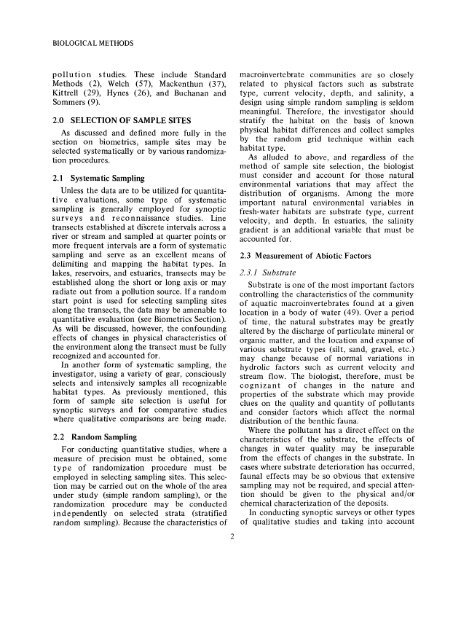Biological field and laboratory methods for measuring the quality of ...
Biological field and laboratory methods for measuring the quality of ...
Biological field and laboratory methods for measuring the quality of ...
You also want an ePaper? Increase the reach of your titles
YUMPU automatically turns print PDFs into web optimized ePapers that Google loves.
BIOLOGICAL METHODS<br />
pollution studies. These include St<strong>and</strong>ard<br />
Methods (2), Welch (57), Mackenthun (37),<br />
Kittrell (29), Hynes (26), <strong>and</strong> Buchanan <strong>and</strong><br />
Sommers (9).<br />
2.0 SELECTION OF SAMPLE SITES<br />
As discussed <strong>and</strong> defined more fully in <strong>the</strong><br />
section on biometrics, sample sites may be<br />
selected systematically or by various r<strong>and</strong>omization<br />
procedures.<br />
2.1 Systematic Sampling<br />
Unless <strong>the</strong> data are to be utilized <strong>for</strong> quantitative<br />
evaluations, some type <strong>of</strong> systematic<br />
sampling is generally employed <strong>for</strong> synoptic<br />
surveys <strong>and</strong> reconnaissance studies. Line<br />
transects established at discrete intervals across a<br />
river or stream <strong>and</strong> sampled at quarter points or<br />
more frequent intervals are a <strong>for</strong>m <strong>of</strong> systematic<br />
sampling <strong>and</strong> serve as an excellent means <strong>of</strong><br />
delimiting <strong>and</strong> mapping <strong>the</strong> habitat types. In<br />
lakes, reservoirs, <strong>and</strong> estuaries, transects may be<br />
established along <strong>the</strong> short or long axis or may<br />
radiate out from a pollution source. If a r<strong>and</strong>om<br />
start point is used <strong>for</strong> selecting sampling sites<br />
along <strong>the</strong> transects, <strong>the</strong> data may be amenable to<br />
quantitative evaluation (see Biometrics Section).<br />
As will be discussed, however, <strong>the</strong> confounding<br />
effects <strong>of</strong> changes in physical characteristics <strong>of</strong><br />
<strong>the</strong> environment along <strong>the</strong> transect must be fully<br />
recognized <strong>and</strong> accounted <strong>for</strong>.<br />
In ano<strong>the</strong>r <strong>for</strong>m <strong>of</strong> systematic sampling, <strong>the</strong><br />
investigator, using a variety <strong>of</strong> gear, consciously<br />
selects <strong>and</strong> intensively samples all recognizable<br />
habitat types. As previously mentioned, this<br />
<strong>for</strong>m <strong>of</strong> sample site selection is useful <strong>for</strong><br />
synoptic surveys <strong>and</strong> <strong>for</strong> comparative studies<br />
where qualitative comparisons are being made.<br />
2.2 R<strong>and</strong>om Sampling<br />
For conducting quantitative studies, where a<br />
measure <strong>of</strong> precision must be obtained, some<br />
type <strong>of</strong> r<strong>and</strong>omization procedure must be<br />
employed in selecting sampling sites. This selection<br />
may be carried out on <strong>the</strong> whole <strong>of</strong> <strong>the</strong> area<br />
under study (simple r<strong>and</strong>om sampling), or <strong>the</strong><br />
r<strong>and</strong>omization procedure may be conducted<br />
independently on selected strata (stratified<br />
r<strong>and</strong>om sampling). Because <strong>the</strong> characteristics <strong>of</strong><br />
2<br />
macroinvertebrate communities are so closely<br />
related to physical factors such as substrate<br />
type, current velocity, depth, <strong>and</strong> salinity, a<br />
design using simple r<strong>and</strong>om sampling is seldom<br />
meaningful. There<strong>for</strong>e, <strong>the</strong> investigator should<br />
stratify <strong>the</strong> habitat on <strong>the</strong> basis <strong>of</strong> known<br />
physical habitat differences <strong>and</strong> collect samples<br />
by <strong>the</strong> r<strong>and</strong>om grid technique within each<br />
habitat type.<br />
As alluded to above, <strong>and</strong> regardless <strong>of</strong> <strong>the</strong><br />
method <strong>of</strong> sample site selection, <strong>the</strong> biologist<br />
must consider <strong>and</strong> account <strong>for</strong> those natural<br />
environmental variations that may affect <strong>the</strong><br />
distribution <strong>of</strong> organisms. Among <strong>the</strong> more<br />
important natural environmental variables in<br />
fresh-water habitats are substrate type, current<br />
velocity, <strong>and</strong> depth. In estuaries, <strong>the</strong> salinity<br />
gradient is an additional variable that must be<br />
accounted <strong>for</strong>.<br />
2.3 Measurement <strong>of</strong> Abiotic Factors<br />
2.3.1 Substrate<br />
Substrate is one <strong>of</strong> <strong>the</strong> most important factors<br />
controlling <strong>the</strong> characteristics <strong>of</strong> <strong>the</strong> community<br />
<strong>of</strong> aquatic macroinvertebrates found at a given<br />
location in a body <strong>of</strong> water (49). Over a period<br />
<strong>of</strong> time, <strong>the</strong> natural substrates may be greatly<br />
altered by <strong>the</strong> discharge <strong>of</strong> particulate mineral or<br />
organic matter, <strong>and</strong> <strong>the</strong> location <strong>and</strong> expanse <strong>of</strong><br />
various substrate types (silt, s<strong>and</strong>, gravel, etc.)<br />
may change because <strong>of</strong> normal variations in<br />
hydrolic factors such as current velocity <strong>and</strong><br />
stream flow. The biologist, <strong>the</strong>re<strong>for</strong>e, must be<br />
cognizant <strong>of</strong> changes in <strong>the</strong> nature <strong>and</strong><br />
properties <strong>of</strong> <strong>the</strong> substrate which may provide<br />
clues on <strong>the</strong> <strong>quality</strong> <strong>and</strong> quantity <strong>of</strong> pollutants<br />
<strong>and</strong> consider factors which affect <strong>the</strong> normal<br />
distribution <strong>of</strong> <strong>the</strong> benthic fauna.<br />
Where <strong>the</strong> pollutant has a direct effect on <strong>the</strong><br />
characteristics <strong>of</strong> <strong>the</strong> substrate, <strong>the</strong> effects <strong>of</strong><br />
changes in water <strong>quality</strong> may be inseparable<br />
from <strong>the</strong> effects <strong>of</strong> changes in <strong>the</strong> substrate. In<br />
cases where substrate deterioration has occurred,<br />
faunal effects may be so obvious that extensive<br />
sampling may not be required, <strong>and</strong> special attention<br />
should be given to <strong>the</strong> physical <strong>and</strong>/or<br />
chemical characterization <strong>of</strong> <strong>the</strong> deposits.<br />
In conducting synoptic surveys or o<strong>the</strong>r types<br />
<strong>of</strong> qualitative studies <strong>and</strong> taking into account















